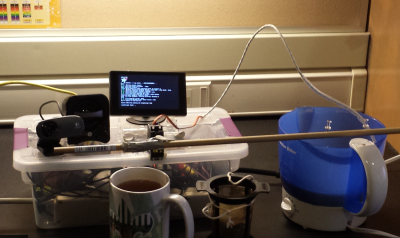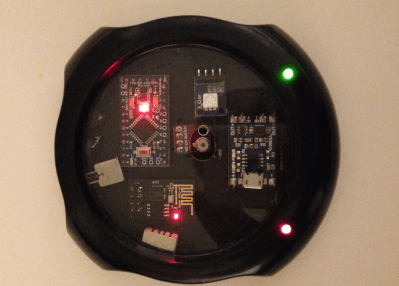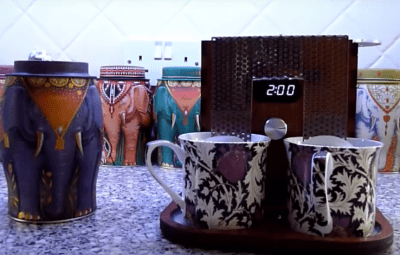Last week on the Hacklet I covered coffee hacks. Not everyone likes coffee though. A good portion of the world’s population enjoys a nice cup of tea. Different cultures are rather particular with how they prepare their drink of choice. Americans tend to use teabags, while British, Chinese (and much of the rest of the globe) generally prefer loose tea leaves. Everyone has their own particular style, which has led to quite a few tea hacks. This week’s Hacklet is all about some of the best tea projects on Hackaday.io!
 We start with [James P.] and Tea Pi. Tea Pi is designed to emulate commercial tea makers costing hundreds of dollars. The heart of the operation is a Raspberry Pi, making this one of the first Linux powered tea makers we’ve ever heard of. An Adafruit PowerSwitch Tail allows the Pi to control a standard tea kettle. The Pi monitors water temperature with a DS18B20 temperature sensor. A simple servo drops a tea basket into the water for brewing. When the time is up, the servo pulls the basket up and the tea is ready to serve. [James P] planned to add voice control to his tea creation. I’m betting that would be pretty easy with Amazon’s voice services for the Raspberry Pi.
We start with [James P.] and Tea Pi. Tea Pi is designed to emulate commercial tea makers costing hundreds of dollars. The heart of the operation is a Raspberry Pi, making this one of the first Linux powered tea makers we’ve ever heard of. An Adafruit PowerSwitch Tail allows the Pi to control a standard tea kettle. The Pi monitors water temperature with a DS18B20 temperature sensor. A simple servo drops a tea basket into the water for brewing. When the time is up, the servo pulls the basket up and the tea is ready to serve. [James P] planned to add voice control to his tea creation. I’m betting that would be pretty easy with Amazon’s voice services for the Raspberry Pi.
 Next up is [Tom] with Eye-O-Tea. With this project, even your cup of tea can join the Internet of Things. Eye-O-Tea essentially is a web connected coaster with temperature monitoring built right in. Temperature is measured with a Melexis MLX90615 IR thermometer. An Arduino Pro Mini reads the temperature and passes it on to an ESP8266 WiFi module. The entire device is powered by a LiPo battery, and neatly housed in a gutted cup warmer. On the cloud side, [Tom] used ThinkSpeak and freeboard.io to make an interface he can access with his cell phone. If his tea is too hot, Eye-O-Tea will let him know. It will also send him an SMS if he’s forgotten his cup and it’s going cold.
Next up is [Tom] with Eye-O-Tea. With this project, even your cup of tea can join the Internet of Things. Eye-O-Tea essentially is a web connected coaster with temperature monitoring built right in. Temperature is measured with a Melexis MLX90615 IR thermometer. An Arduino Pro Mini reads the temperature and passes it on to an ESP8266 WiFi module. The entire device is powered by a LiPo battery, and neatly housed in a gutted cup warmer. On the cloud side, [Tom] used ThinkSpeak and freeboard.io to make an interface he can access with his cell phone. If his tea is too hot, Eye-O-Tea will let him know. It will also send him an SMS if he’s forgotten his cup and it’s going cold.
 Next we have [Adrian] and ChaiBot. Chaibot was created by [Adrian’s] son [Oliver] to combat a common problem. Both father and son would pour cups of tea, then get involved in a project. By the time they came back, they had ink. ChaiBot steeps the tea for a set amount of time, stirring every minute. The mechanics of the project came from an old CD-ROM drive. A PIC16F887 runs the show, ensuring the steep time is accurate, and activating the motor drive. When the tea is done, an ESP8266 sends a push notification to the user’s phone. The project is housed in a wooden case that fits perfectly on the kitchen counter.
Next we have [Adrian] and ChaiBot. Chaibot was created by [Adrian’s] son [Oliver] to combat a common problem. Both father and son would pour cups of tea, then get involved in a project. By the time they came back, they had ink. ChaiBot steeps the tea for a set amount of time, stirring every minute. The mechanics of the project came from an old CD-ROM drive. A PIC16F887 runs the show, ensuring the steep time is accurate, and activating the motor drive. When the tea is done, an ESP8266 sends a push notification to the user’s phone. The project is housed in a wooden case that fits perfectly on the kitchen counter.
 Finally, we have [Siggi] with Camper Induction Cooker, a 2016 Hackaday Prize entry. [Siggi] needed hot liquids on the go, but he didn’t want to fool around with heating elements. An induction heater was the way to go. A Cypress PSOC micro controls the system. Metal travel style mugs can be used without modification. For ceramic or plastic mugs, a metal washer (hopefully coated with something food safe) acts as an immersion heater. The project is definitely a bit unwieldy at the moment, but I could see [Siggi’s] idea being incorporated into automotive cup holders. [Siggi] put his project on hold back in June. I hope seeing his work on the front page will get development moving again.
Finally, we have [Siggi] with Camper Induction Cooker, a 2016 Hackaday Prize entry. [Siggi] needed hot liquids on the go, but he didn’t want to fool around with heating elements. An induction heater was the way to go. A Cypress PSOC micro controls the system. Metal travel style mugs can be used without modification. For ceramic or plastic mugs, a metal washer (hopefully coated with something food safe) acts as an immersion heater. The project is definitely a bit unwieldy at the moment, but I could see [Siggi’s] idea being incorporated into automotive cup holders. [Siggi] put his project on hold back in June. I hope seeing his work on the front page will get development moving again.
If you want to see more tea projects, check out our new tea projects list. See a project I might have missed? Don’t be shy, just drop me a message on Hackaday.io. That’s it for this week’s Hacklet, As always, see you next week. Same hack time, same hack channel, bringing you the best of Hackaday.io!















Us Brits almost exclusively use Teabags too.
But first you spoil every cup with a huge amount of milk. Yuck!
+1
The blends we drink with milk tend to be far stronger than what I have found overseas so you need a little splash of milk to balance the bitterness. Once the ratios are right, with a good tea blend and no sugar, its one of the most delicious and refreshing beverages about.
And on that note, I’m off to the kitchen to make what we call “Builders Tea”.
Why would anyone use teabags?
Because dealing with the mess of tea leaves and all that strainer nonsense is just a drag that died out with my grans generation, most people just swirl the bag round in a mug with a spool for a bit and get on with more interesting stuff.
Brit here, I don’t know anyone using leaves still either.
I hack coffee quite a bit mostly cold extract or aeropress right now with some Starbucks Via for on the road. I mostly do PG Tips for tea though because I have trouble finding a consistent quality supply of high vitamin C(affeine) blend where I live. Cold extract works pretty good for tea concentrate though, but I think that is just what iced tea has always been anyways.
The problem with teabags is that they contain all the dreck (leaf powder, crushed stems, floor sweepings…) left over after loose tea is produced. If you saw how this stuff is produced in China (my wife is from Guangzhou, and we’ve toured the tea producers) and, I’m sure, Sri Lanka, india, and other suppliers, you would never, ???????????????? want to use tea bags again (I sure as hell wouldn’t, anyway). Heck, you might even hesitate to use loose tea (I still risk it, even after seeing kids sorting it on the concrete floors where everyone has been spitting). Oh, and the “deep, rich” color from Lipton (for example) tea bags? You don’t want to know…
BTW, the Chinese rinse their loose tea several times just before using it. Clearly, they know something that most of the rest of us don’t, though I doubt that the rinsing really does much good.
https://media3.giphy.com/media/RGRhvqkg7anTO/giphy.gif
Exactly. My wife is from Wuyishan, and her family owns a tea farm. The standard harvesting procedure in the region involves a curved hedge trimmer. The fresh leaves are then dumped out onto a tarp at the entrance to the tea factory while they wait processing. At no time are the tea leaves washed, since that would impact the process and change the resulting product.
Loose leaf tea is a cleaner product for a few reasons. First it is the higher grade product. Tea bags, like ground beef, may contain the dust left over from many sacks of finished product. Second, at least in Wuyishan, the leaves are sorted using a air screen, resulting in a relatively dust free product.
The sorting process is done part way through the manufacturing process. Since each stage of tea manufacture requires machine time and labor it would be nice to do very early in the process, but as soon as the tea leaves are harvested there is a short window to process them before they go bad. In Wuyishan this means that the tea is processed to the point that it looks like tea, but has not completed the final roasting step. The mechanical sorting seeks to separate the sticks from the tea leaves, and the low quality leaves from the first and second quality leaves. Low quality leaves are generally sold for use in tea releated products, such as tea stuffed pillows, or any tea infused or flavored products. The first quality leaves are finished more carefully and hand sorted to create a premium product. The second quality leaves may be sold to a bulk dealer for export or mass market sales (grocery stores).
As Rodney mentioned, Lipton tea instantly creates a dark color not because of any quality, but to my knowledge because of the excessive amounts of fine particulates.
I drink a lot of tea, and don’t mind what goes into the production. You can rest assured that tea is quite safe to drink. Almost every step does something that improves it’s sanitation, such as extended heating, and drying.
{facepalm} I’ll leave it to y’all to judge for yourselves the discrepancies here.
Don’t underestimate the ability of the average person to not care about this :-)
Case in question, I still eat sausages and I’ve seen what goes into them too.
I’ll take bits of guts any day over third-world floor sweepings.
Hey why not just use loose leaf tea bags, the best of both worlds, I use them all the time.
https://www.amazon.ca/T-Sac-Disposable-Paper-Filter-Count/dp/B001BLCIN4
(And sadly I get no kickback, just to show you what I mean.)
That’s what my wife & I use while traveling, though we use a cheapie version from AliExpress (Chinese tea should go into Chinese bags, right?). I’m still trying to figure out what floor sweepings go into making the bags–I like to think it’s worm spit from a silk factory.
OMG, that last sentence made me sick lol.
That induction heater must transmit quite well, all over the campground. No need for further notification. Then burn your self on a hot cup. Ouch.
Pumper type pod coffee makers are great to hack. Once people realize how expensive the pods are and trash intensive, they throw out the maker too. The only thing to hack is the way the hot water comes out and goes thru a Melita filter cone or right into the tea cup.
Try that with Twinings.
Fortunately the networking side of an internet connected hot drinks machine has been standardised for several years now, with RFC2324 defining the Hyper Text Coffee Pot Control Protocol.
Presumably all of the machines featured here would return HTTP status code 418 “I’m a teapot” (entity may be short and stout).
https://en.wikipedia.org/wiki/Hyper_Text_Coffee_Pot_Control_Protocol